Gantries are ‘can-do’ tool
17 May 2021
Gantry systems extend the realm of industrial lifting heavier and higher.
A prerequisite of a successful rigging company is a “can do” mentality. Today’s riggers create solutions for projects that previously may have been put in a “not possible” category. One of the rigging systems that is the most “can-do” is the gantry.
Gantry systems are alternative lifting tools that come into play when a crane or other lifting device has been ruled out. In many cases, gantries offer routine lifting. In other cases, sophisticated gantry systems are the only solution for moving machinery, presses and other equipment that needs replacing or repairing.
ACT rounded up an interesting array of gantry jobs using rigging schemes that resulted in a safe, successful project.
Covid-19 protocols including testing, social distancing and wearing masks were implemented on all of these projects.
Press lift and set
Lee Machinery Movers was tasked with installing a new 7,500-ton Schuler press line within one of its customers’ plants in Kansas City, MO. The press parts were originally delivered to the customer’s facility in Michigan. Lee Machinery Movers coordinated the load out and transportation of 15 super loads and 41 miscellaneous truck loads to Kansas City prior to the installation.
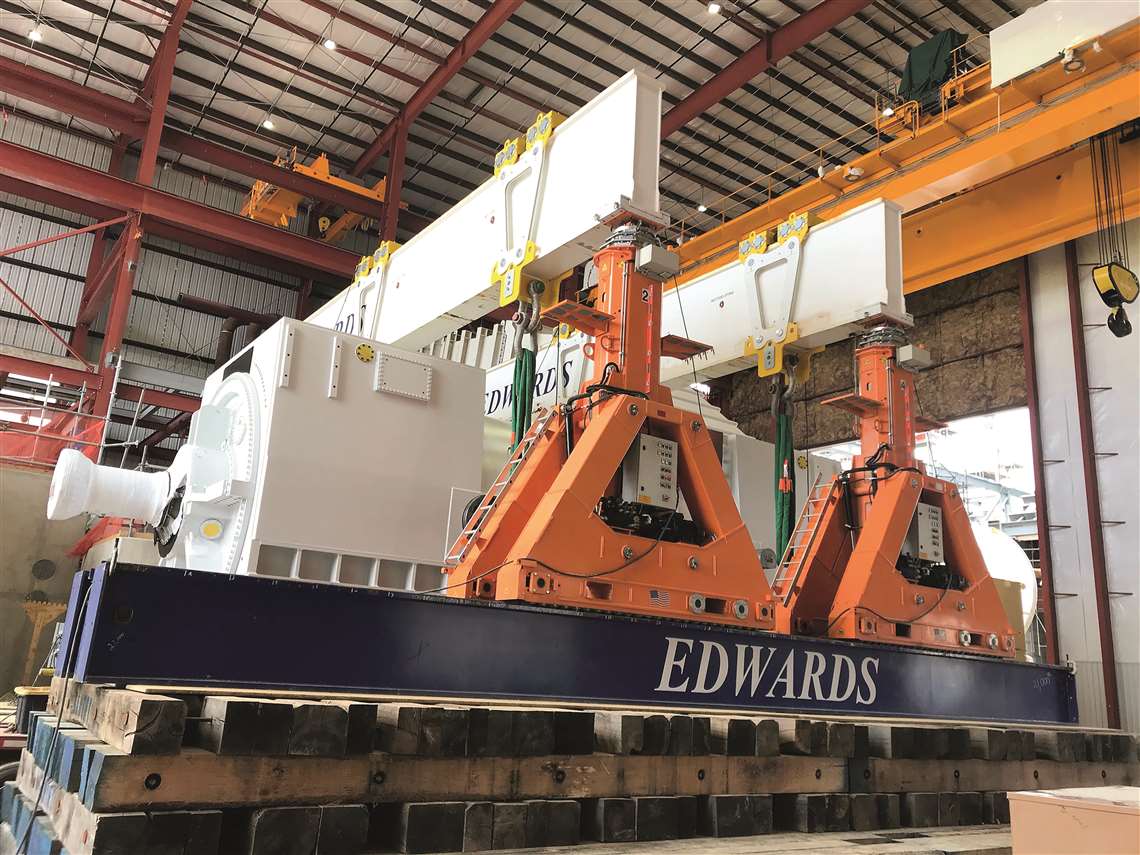 Using the Enerpac SBL1100 hydraulic gantry’s ability to travel and the 660-ton side shift system, the generator was safely lifted onto the elevated pedestal.
Using the Enerpac SBL1100 hydraulic gantry’s ability to travel and the 660-ton side shift system, the generator was safely lifted onto the elevated pedestal.
“Once we offloaded all the parts on site in Missouri, our team of heavy machinery movers put together a plan to utilize two of our 600-ton capacity gantries to pick and set the lead crown weighing in at 505,000 pounds, the trickiest part of the install,” said the Lee team.
The two gantries were Riggers Manufacturing EZ 604 hydraulic gantry systems.
The Lee team travelled 140 feet with the crown up in the air and the gantry stroked out at 35 feet in order to clear the tie-rods and to set the crown on the uprights. Executing this portion of the install as efficiently as they did set the tone for the remainder of the project, ensuring that the Lee team completed the press line safely and on schedule with complete customer satisfaction.
Side shift and lift
Edwards Moving & Rigging recently provided heavy haul services on a large combined-cycle plant in the northeast. As Edwards was nearing the completion of its scope of work, the team was confronted with a challenge. To address some schedule shifts, the customer decided to ship the generators threaded, significantly increasing the weight. To ensure sufficient capacity of the gantry at the rail siding, Edwards’ engineering team designed and fabricated a spreader beam system that was used to lift the 873,500-pound generator. This setup accommodated a side shift of the heavier components to a three-file Goldhofer PST platform trailer. The trailer was transversely positioned at a point significantly off the centerline.
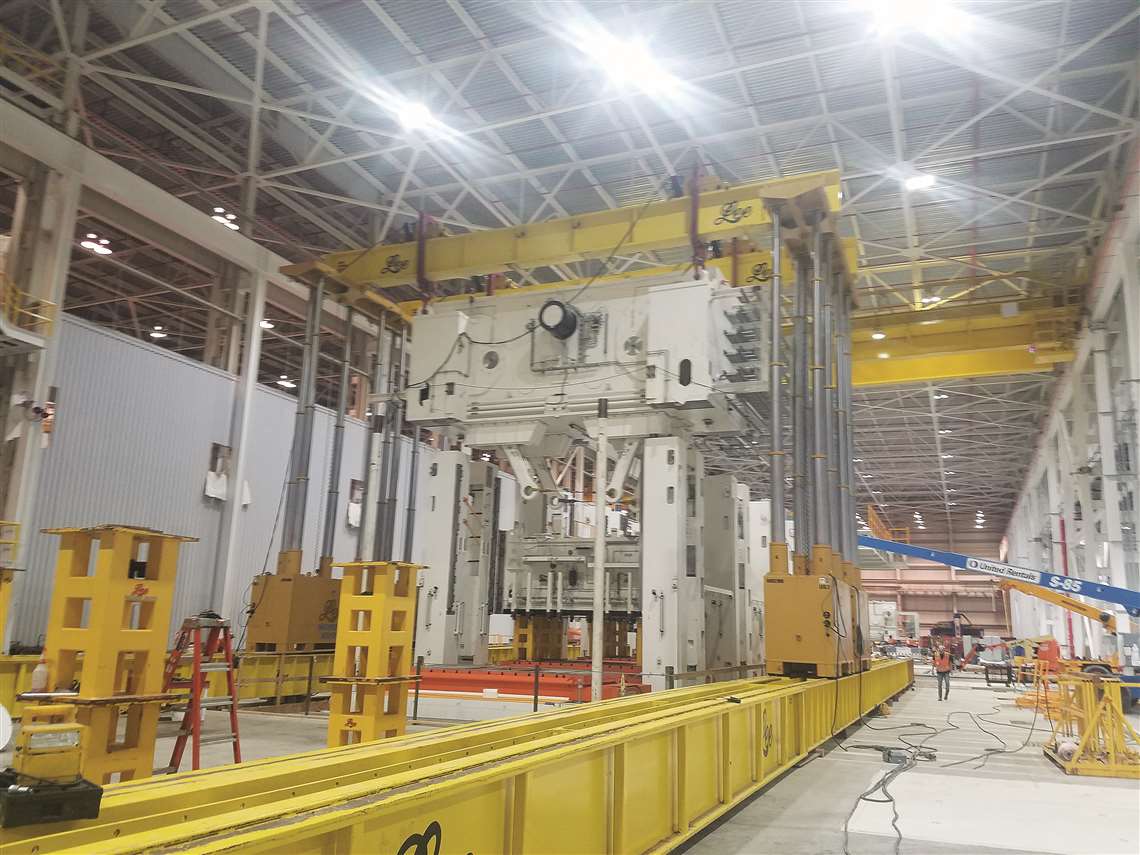 The crown traveled 140 feet in the air. The gantry stroked out at 35 feet to clear the tie-rods and to set the crown on the uprights.
The crown traveled 140 feet in the air. The gantry stroked out at 35 feet to clear the tie-rods and to set the crown on the uprights.
Edwards faced a bigger challenge inside the generator building. The schedule shift on the generators potentially impacted the pace of construction, so a solution was needed to set the threaded generators with the turbines already in position.
Edwards brought in the perfect tool to the table to meet this challenge. Edwards’ engineers had previously designed and custom built a set of lightweight 660-ton capacity long span box girder beams. This allowed Edwards more than enough capacity to lift the 873,500-pound generators with a track gauge of 60 feet. The large track gauge was critical to the process, as the self-propelled trailer was then able to be transversely positioned at a point significantly off the centerline.
Utilizing an Enerpac 1,100-ton gantry rented from Engineered Rigging, Edwards had the tools in place to begin the lift. Between the capacity of the gantry travel and Edwards’ 660-ton side shift system manufactured by Enerpac, the generators were placed on the elevated pedestals from transverse positions, rather than a linear position. Edwards’ engineered solutions enabled the customer to accelerate the construction schedule and safely set the threaded generators safely and efficiently.
The Enerpac SBL1100 hydraulic gantry with custom SSU600 side shifts are designed to fit tall header beams. This state-of-the art piece of equipment has the ability to shift extremely heavy loads over a large span – in this case, 50 percent longer than the typical 40-foot standard. The system solution allowed a self-propelled platform trailer to position the cargo significantly off system centerline, then to transversely shift the load into its final position. The Enerpac SSU600 side shift features electrical propulsion trolleys to shift the load along the beam and operates from the Intelli-Lift wireless gantry controls of the SBL1100.
In with the new
Last spring, Contracting Mexico IICC (CM IICC) was awarded a project at a plant in Mexico to remove an existing double action lead draw press and install with a single action 2,500-ton press with a hydraulic cushion as part of a new product launch.
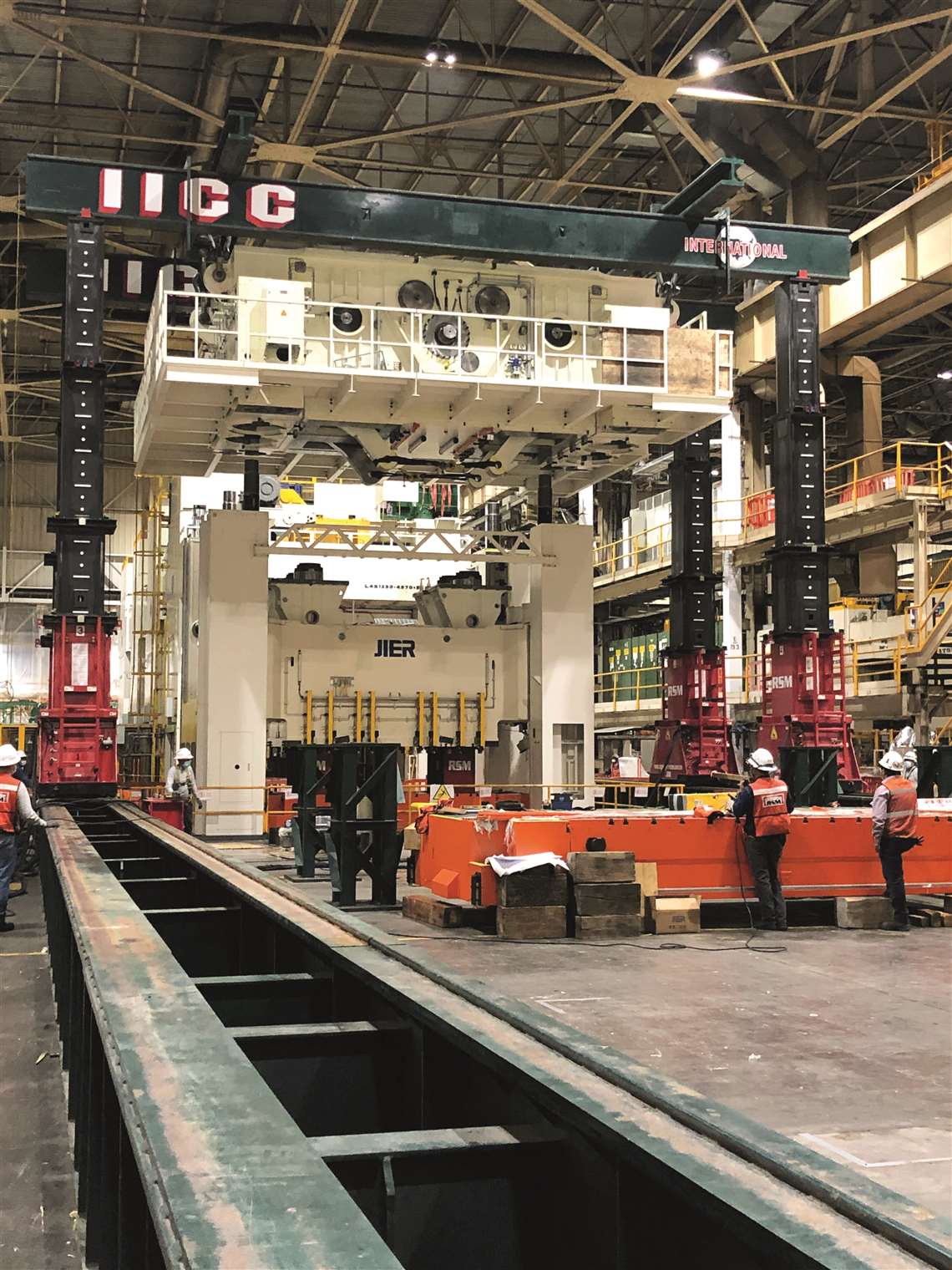 A 650-ton capacity Lift Systems Power Tower Model 34PT6550WT gantry system with four legs was used for all the lifts for the press installation in Mexico.
A 650-ton capacity Lift Systems Power Tower Model 34PT6550WT gantry system with four legs was used for all the lifts for the press installation in Mexico.
The project consisted of the removal of the existing press, removal and reinstallation of the existing Front of Line (FOL) automation, demolition of the press room floor and existing press piers, fabrication and installation of the new press piers and press room floor and the installation of the new 2,500-ton press.
With the timing tied to the launch of a new vehicle, the project schedule was two shifts, seven days per week. The existing FOL had to be match marked and staged on site and the existing press had to be removed, taken outside and scrapped. While the existing press was being sized for transportation offsite, the existing press room floor was demoed, and the existing press piers were sawcut at the base and removed from the pit in one piece using engineered lifting lugs for the 55,000-pound monoliths.
As soon as the old flooring was removed, the new flooring, which was fabricated in modules for faster installation, was installed. The new press piers were pre-cast and set into the pit in one piece, with the concrete already set at 100 percent of cure.
“This allowed us to immediately begin preparations to start setting the new 2500-ton press bed,” said CM IICC. “The new press was brought in the sub-assembly area using plant production aisles which required a very coordinated effort between the production and installation teams.
A 650-ton capacity Lift Systems Power Tower Model 34PT6550WT gantry system with four legs was used for all the lifts.
Given its tight spaces and short schedule, the project was a success due to some “out of the box” thinking. The new press was turned over to the owner two weeks ahead of schedule.
Receiving a reactor
Mammoet received a 368-ton reactor via rail car. The reactor was placed underneath a 700-ton capacity J&R Engineering model T1402-4-39 Lift-N-Lock Hydraulic Octagon Boom Gantry. The gantry system was assembled ahead of time. The crew secured and lifted the reactor off the railcar and set it onto 24 axle-lines of SPMT. Once in place, the team transported the reactor across the jobsite to the area for offloading.
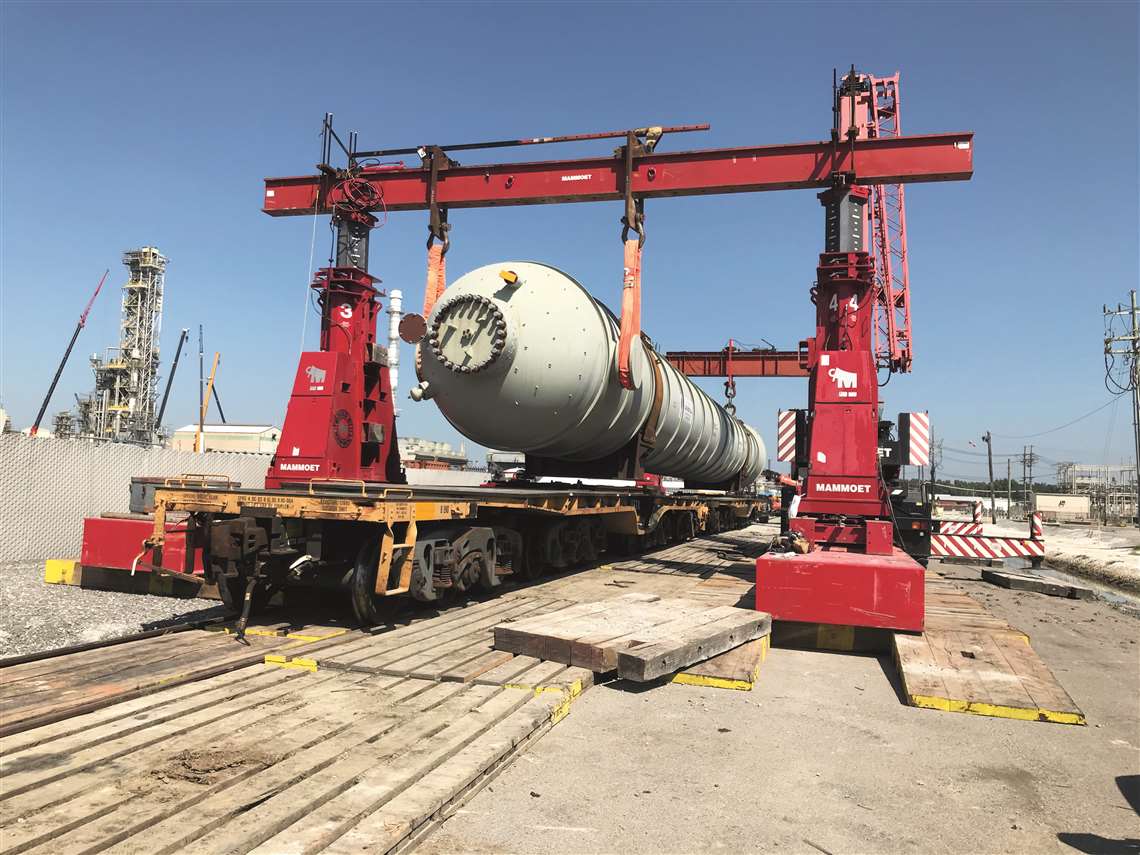 The Lift-N-Lock gantry header beams were very stout due to the heavy weight of the reactor coupled with a long span between the gantry lift housings.
The Lift-N-Lock gantry header beams were very stout due to the heavy weight of the reactor coupled with a long span between the gantry lift housings.
The Lift-N-Lock gantry then was used for the vertical lifting above the load’s pedestal and travelled the load with the integrally designed planetary drives of the loaded axles for over the pedestal. The octagon lift booms were then lowered and the side shifting hydraulic system was used to power a push-pull cylinder atop the gantry header beam for the final placement.
One of the challenges was limited space around the rail offload area, making the assembly area tight. The Lift-N-Lock gantry header beams were very stout due to the heavy weight of the reactor coupled with a long span between the gantry lift housings. The rigging assembly on the tail end of the reactor was challenging because of very large and heavy capacity shackles needed to be used on account of the weight of the reactor.
In the end, the reactor was successfully offloaded and set for further use by the client.
On the rails
To re-deck the US-69 bridge, which is suspended above a damn in Eufaula, OK, contractors rented a MJ50HD Travelift from Mi-Jack Products. An innovative erection was required given the exceptionally tight workspace.
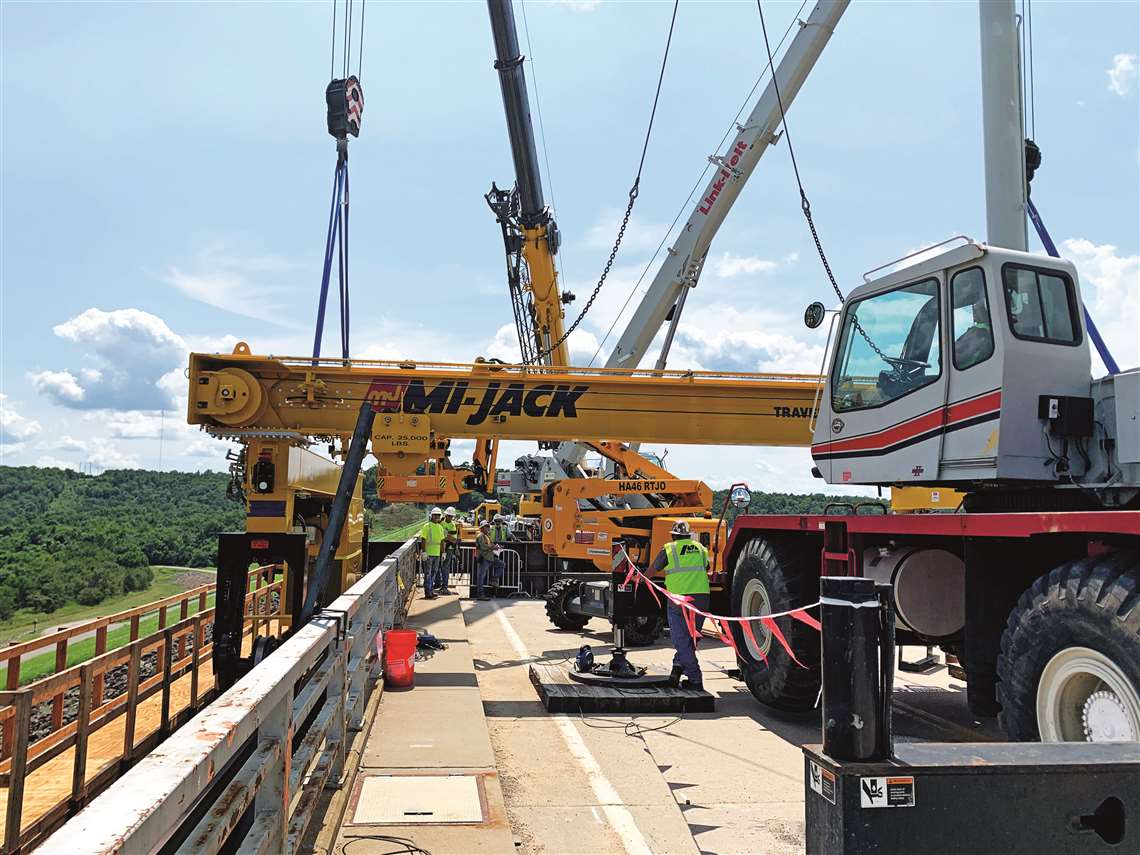 The Mi-Jack MJ50HD, which has a capacity of 100,000 tons, is being used to re-deck a bridge in Oklahoma.
The Mi-Jack MJ50HD, which has a capacity of 100,000 tons, is being used to re-deck a bridge in Oklahoma.
Putting the crane on rails was required given the lack of space. The gantry crane was equipped with all-wheel drive to minimize potential slippage that can occur from adverse weather conditions when there is steel on steel. Construction on the damn was required to hold the rails.
There was nowhere to lay out the horseshoes and side beams so three cranes had to be leveraged for erection. The lugs were relocated on the side beams and top beams based on the MJ50HD’s center of gravity to keep the side beam rail wheels plum when suspended from the two cranes, and the top beam was hoisted with one crane at the same time. The top beam connected the side beams together, allowing them to balance on the rail without the cranes holding the side beams. That freed up two cranes to be able to land the columns and top beam to complete one horseshoe connection. The top beam holding the side beams together was then able to be removed to install the last two columns and top beam to complete all major structural connections.
Despite the unique challenges involved, including Covid-19 protocols, the erection was completed quickly.
The MJ50HD has a capacity of 100,000 tons, an inside clear width of 40 feet, a hook height of 28 feet 10 inches and a wheelbase of 30 feet. An auxiliary hoist option allowed decking to be picked vertical and rotated flat. Biodegradable hydraulic oil was used to ensure both high performance and environmental friendliness.
Transformer haul/install
Crane Service Inc., an ML Crane Group Company, was requested to relocate a large transformer for a major utility supplier in the southwestern U.S. Crane Service chose to use its Enerpac SPL 500 hydraulic gantry system to lift and transfer the transformer from its Faymonville APMC ModulMax platform trailer to its DualMax trailer for the over-the-road transport.
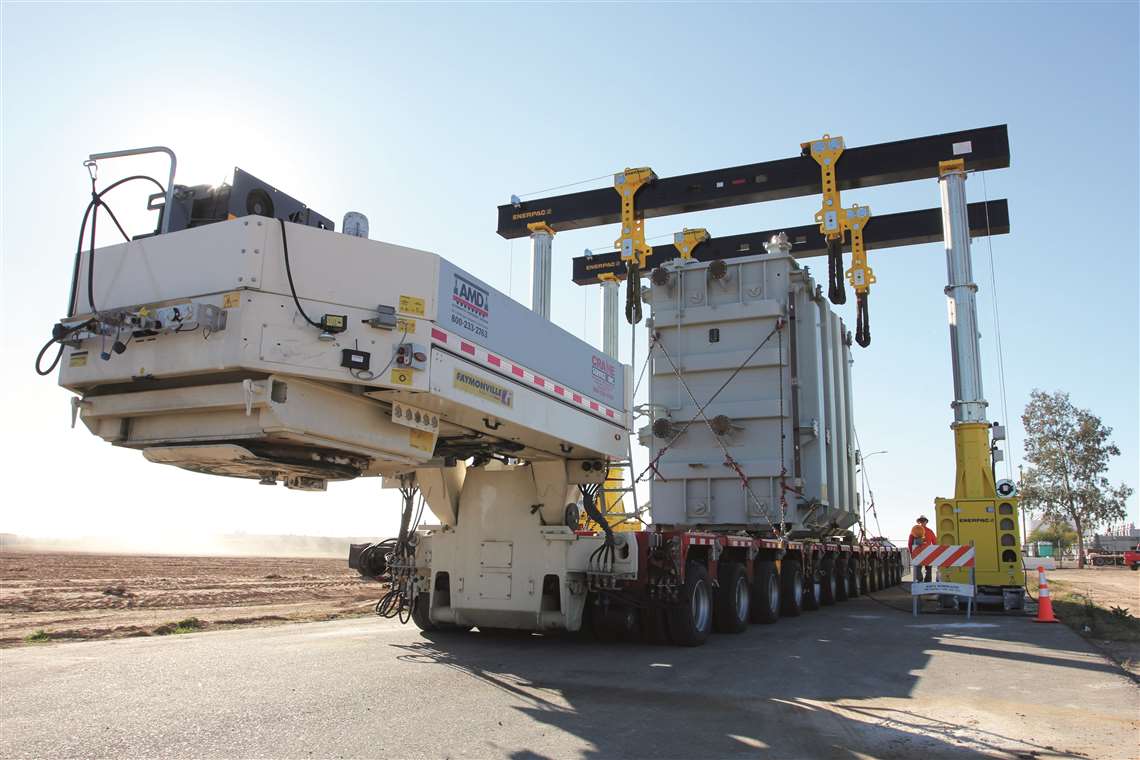 Two Faymonville trailer systems and an Enerpac SPL gantry were used to relocate a transformer in a utility plant.
Two Faymonville trailer systems and an Enerpac SPL gantry were used to relocate a transformer in a utility plant.
Starting from a tight space within the working power plant, the Crane Service team was able to move the transformer off of a concrete pad and transfer it using the AMPC ModulMax trailer to an area outside of the plant before prepping for the road travel.
Addressing this project, ML Crane Group’s Scott Wilson said “the APMC ModulMax is great for working inside the power plant, but it doesn’t meet Arizona bridge weight axle requirements.”
“To mitigate this, we transferred the load to our DualMax trailer before travelling over the road to meet Arizona DOT requirements,” Wilson said.
The Enerpac SPL 500 hydraulic gantry system is capable of handling 585 tons in capacity. It works in tandem with an electronic slide shift skid track with allows it to move suspended loads seamlessly from side to side.
Pressing installation
Kittyhawk Products, a hot isostatic pressing company in Garden Grove, CA, was charting new territory: the small, family-run business recently opened a second manufacturing facility in Canby, OR. The company provides services to the casting industry and opening this new facility would allow them to serve their growing customer base in the Pacific Northwest. This growth would include the installation of four potential presses in the new facility. Omega Morgan’s Portland machinery moving crews were called on to install the first of the four presses. Space was tight and delays presented challenges, but this is where its machinery moving crews shine, according to Omega Morgan.
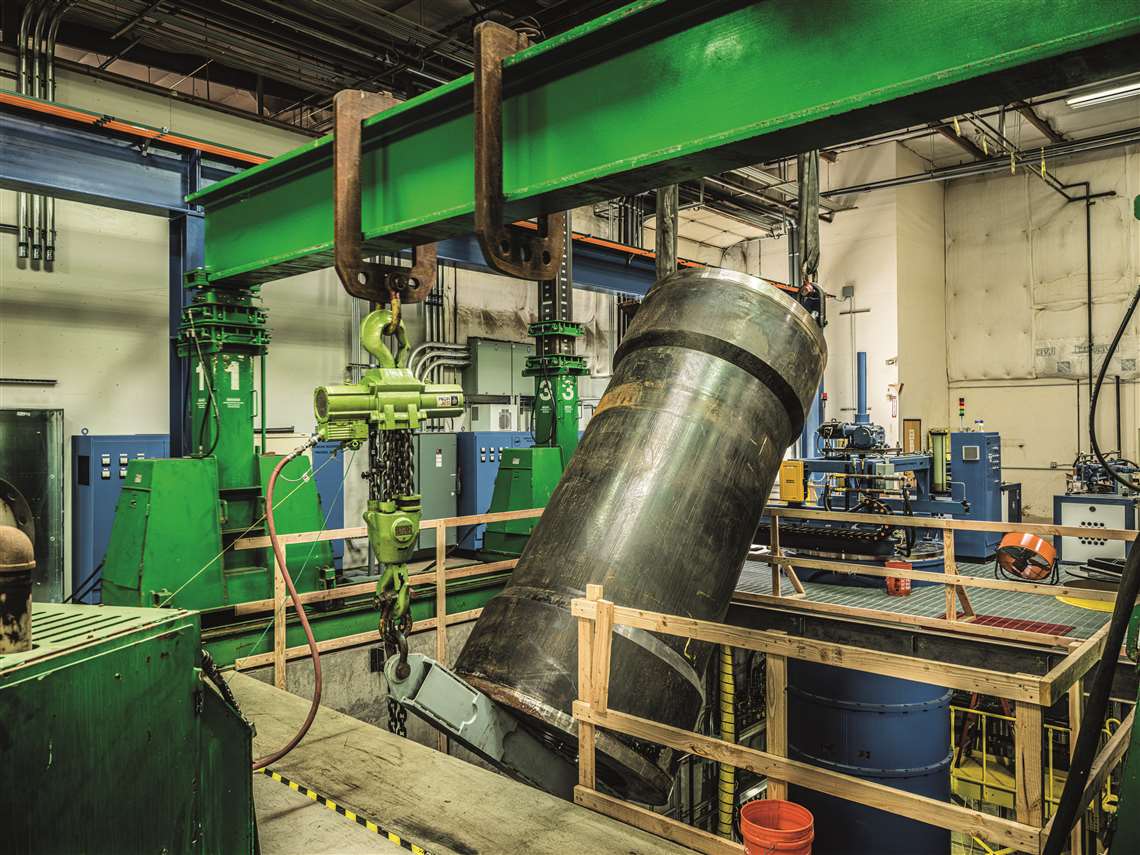 Designing and custom-building a gantry system, working nights and weekends, Omega Morgan was intent on doing whatever needed to be done to reduce any delays to the project.
Designing and custom-building a gantry system, working nights and weekends, Omega Morgan was intent on doing whatever needed to be done to reduce any delays to the project.
The first item to tackle was the extremely tight workspace. The rigging challenge was unique: Omega Morgan’s team wasn’t able to open any penetrations in the roof to lower the press in by crane from the outside.
“Even if we uprighted the press outside, it was too tall, and the facility’s doorways were too short to move it indoors,” Omega Morgan said. “It was no easier inside the facility – there wasn’t enough headroom to upright the press without utilizing the pit the presses would sit in once they were installed. The headroom limited our gantries to under eight feet of stroke, making the process of uprighting the 16-foot-long vessel very complex.”
Delays also cropped up. Transportation of the press was held up due to permitting. This delay could set off a cascade of other delays – manufacturer’s representatives and other trades were all scheduled to do work based on the original delivery date, which looked very much in question.
“Before we started on the project, we took time to figure out the exact rigging lengths, which would be critical when working in such a tight space,” said Omega Morgan.
 The Lift-N-Lock gantry header beams were very stout due to the heavy weight of the reactor coupled with a long span between the gantry lift housings.
The Lift-N-Lock gantry header beams were very stout due to the heavy weight of the reactor coupled with a long span between the gantry lift housings.
The Omega Morgan team executed the move using a custom-built, 250-ton gantry and an Omega Morgan designed and fabricated lifting bracket. To make sure the customer wouldn’t be affected by the shipping delays, Omega Morgan’s crews worked long hours into the nights and weekends so the press would be installed on time.
“We’re thrilled to have had the opportunity to support Kittyhawk’s growth and expansion into the Pacific Northwest with the installation of this hot isostatic press, and we’re proud of our machinery moving team for using their expertise to ensure the complex installation happened,” said Omega Morgan.
Stator caper
Barnhart Crane & Rigging was tasked with the removal and replacement of a 1,073,000-pound U1 Stator in support of the PSEG Generator Modernization Project during the 1R27 outage. The existing stator was located on a 47-foot, 7-inch tall pedestal on top of a building, while the replacement stator was staged outside near the plant dock.
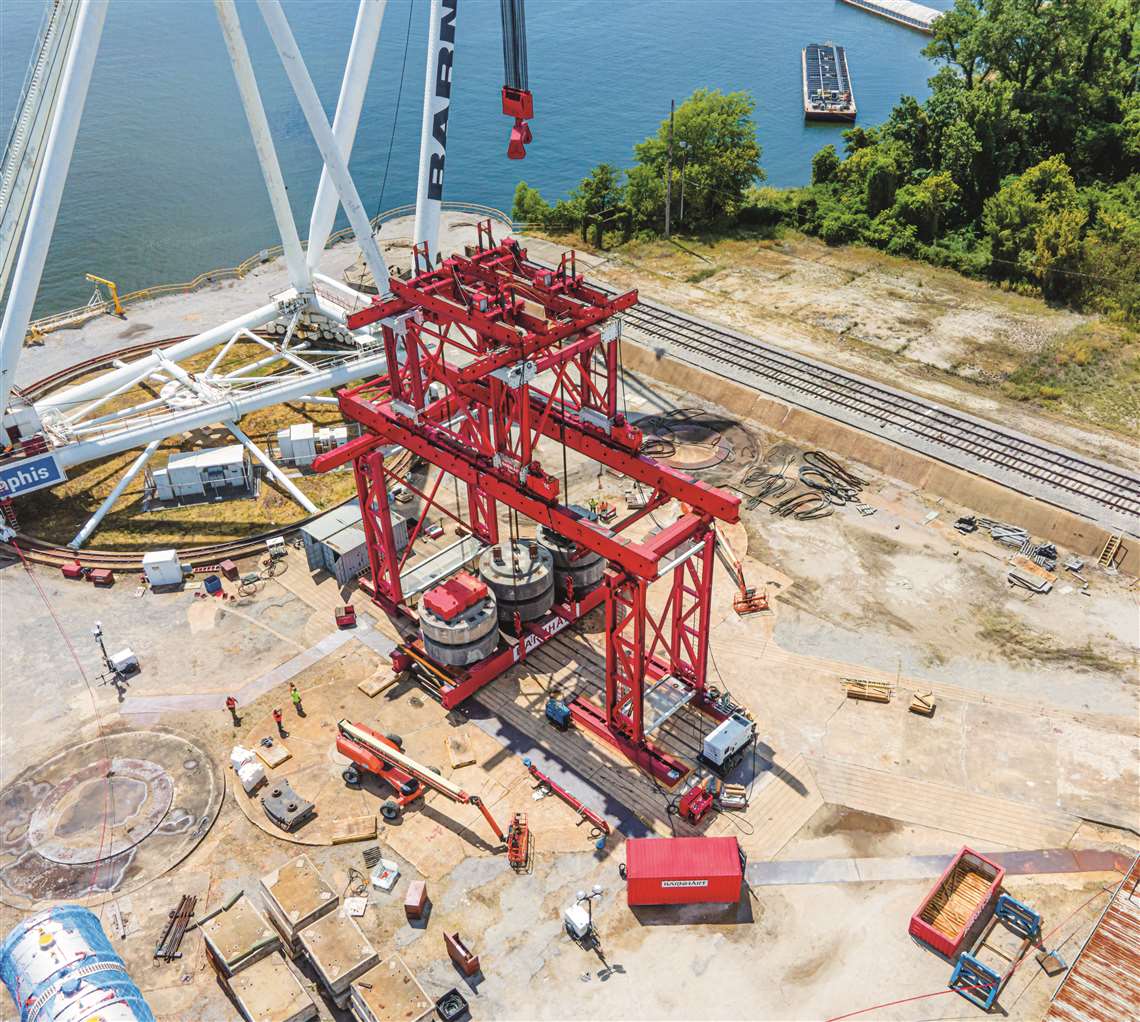 The Barnhart team load tested the lift tower to 125 percent or 1,332,160 pounds, at its Memphis, TN yard. There was one foot of clearance between the turbine building and stator during the lift tower operation.
The Barnhart team load tested the lift tower to 125 percent or 1,332,160 pounds, at its Memphis, TN yard. There was one foot of clearance between the turbine building and stator during the lift tower operation.
Barnhart provided an engineered lift tower (consisting of four 220-ton strand jacks on a BCR sliding tower system), a 750-ton hydraulic turntable and slide system to rotate the stator beneath the lift tower, a hydraulic transporter for onsite transport of the existing and replacement stator, hydraulic gantries to load and unload the stator staged adjacent to dock and engineered a plan/method statement.
The job included copious load testing. The Barnhart team load tested the lift tower to 125 percent or 1,332,160 pounds, at its Memphis, TN yard. Barnhart match marked more than 660 components and transported them to PSEG Salem for reassembly.
Barnhart also load tested the lift tower footer (reinforced concrete footer designed and installed by PSEG) in the alleyway at the project site with a minimum of 1,380,000 pounds of test weight. They also load tested the PSEG overhead turbine crane with 396,000 pounds of test weight.
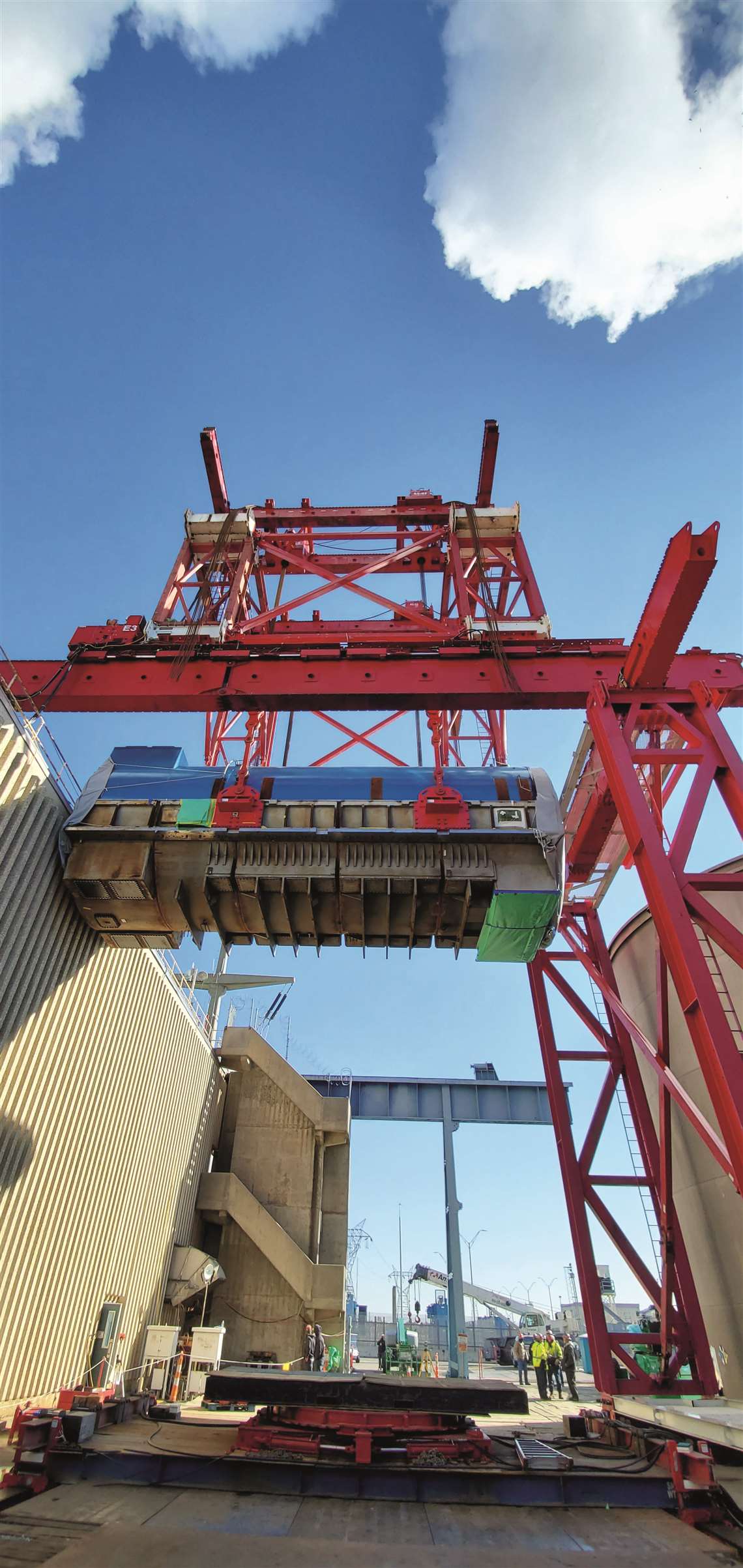 Barnhart Crane & Rigging was tasked with the removal and replacement of a 1,073,000-pound U1 Stator in support of the PSEG Generator Modernization Project during the 1R27 outage.
Barnhart Crane & Rigging was tasked with the removal and replacement of a 1,073,000-pound U1 Stator in support of the PSEG Generator Modernization Project during the 1R27 outage.
There was a very tight footprint. The Lift Tower was snug between two demin water tanks, overhead gantry crane bents and a turbine building. Underground utilities required shoring as well as matting of the entire area. There was approximately one foot of clearance between the turbine building and stator while the lifting tower was in operation. The stator required a rotation of 90 degrees once at grade to load to a Goldhofer system.
If these challenges weren’t enough, a tropical storm hit during erection of the tower causing some erosion.
As summed up by the customer, the project required more than 50 calculation packages and 70 drawings generated, ITPR and approved; lifted and moved over 14,000,000 pounds; completed load tests of Lift Tower (MLT) footing and gantry, each with over 1,300,000 pounds; match marked and reassembled over 600 components of the lift tower after the load test. All work was completed safely without incident.
STAY CONNECTED


Receive the information you need when you need it through our world-leading magazines, newsletters and daily briefings.



